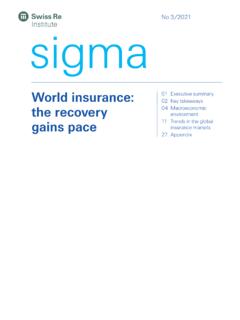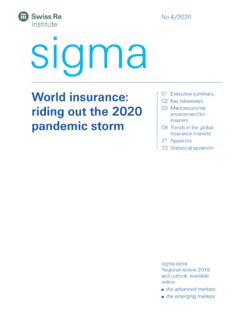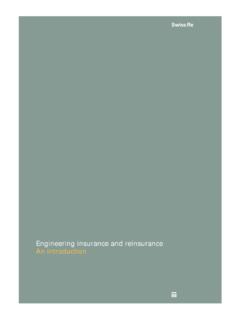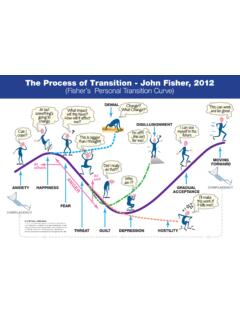Transcription of April 2021 The economics of climate change: no ... - Swiss Re
1 April 2021 The economics of climate change: no action not an option01 Executive summary02 Key takeaways04 climate change: economic risks and uncertainties09 Assessing the economic impacts of climate change20 transition risks: the potential financial implications of moving to a low-carbon economy22 Mitigating climate change risks26 Conclusion27 Appendix 1: traditional modelling approaches28 Appendix 2: GDP-impact scenario analysis set-upSwiss Re Institute The economics of climate change: no action not an option April 2021 1 The world stands to lose close to 10% of total economic value by mid-century if climate change stays on the currently-anticipated trajectory, and the Paris Agreement and 2050 net-zero emissions targets are not met. Many emerging markets have most to gain if the world is able to rein in temperature gains. For example, action today to get back to the Paris temperature rise scenario would mean economies in southeast Asia could prevent around a quarter of the gross domestic product (GDP) loss by mid-century that they may otherwise suffer.
2 Our analysis in this report is unique in explicitly simulating for the many uncertainties around the impacts of climate change. It shows that those economies most vulnerable to the potential physical risks of climate change stand to benefit most from keeping temperature rises in check. This includes some of the world's most dynamic emerging economies, the engines of global growth in the years to come. The message from the analysis is clear: no action on climate change is not an option. Recent scientific research indicates that current likely temperature-rise trajectories, supported by implementation of mitigation pledges, would entail C global warming by mid-century. We use this as the baseline to simulate the impact of rising temperatures over time, while also modelling for the uncertainties around most severe possible physical outcomes.
3 The result is that global GDP would be 11 14% less than in a world without climate change (ie, 0 C change). Under the same no climate change comparative, the Paris target too result in negative GDP impact, but less much so ( ). We also consider a severe scenario in which temperatures rise by C by mid-century, with society doing nothing to combat climate change. In this scenario, the global economy would be 18% smaller than in a world without warming, reinforcing the imperative of, if anything, more action on climate change. In terms of exposure to severe weather risks resulting from climate change, south east Asia and Latin America will likely be most susceptible to dry conditions. Many countries in north and eastern Europe, meanwhile, are set to see more excess precipitation and flood events. Combining these observations with our GDP-impact analysis, our climate economics Index indicates that many advanced economies in the northern hemisphere are least vulnerable to the overall effects of climate change, being both less exposed to the associated risks and better resourced to cope.
4 The US, Canada and Germany are among the top 10 least vulnerable. Of the major economies, China ranks lower, in part due to lesser adaptive capacity in place today relative to peers. However, with rising investment in green energy and increasing awareness of climate risks, we believe China is on course for rapid catch-up addition to physical, climate change also gives rise to transition risks. These can show in large shifts in asset values and higher cost of doing business as the world moves to a low-carbon economy. As a separate exercise, we use carbon-tax scenario analysis as a proxy to gauge the associated financial and economic impacts. We find that earnings in the utilities, materials and energy sectors would be the most impacted and lose between 40 80% of earnings per share by immediate imposition of a global carbon tax of USD 100 per metric ton.
5 By region, revenue-weighted earnings would fall by about a fifth in Asia Pacific, and by 15% in the Americas and Europe. The scale of loss depends on the speed at which carbon taxes and mitigation actions are implemented, and the pace of technological adoption. climate risk is a systemic risk, one that can be managed with coordinated global policy action. There exists a unique opportunity to green our economies. The public and private sectors, including insurers as providers of risk transfer capacity, risk knowledge and long-term investment, can facilitate transition to a low-carbon economy. Increasing transparency, data and disclosure to price and transfer risks is needed. To this end we should see more policy action on carbon pricing coupled with incentivising nature based and carbon-offsetting solutions. International convergence on the taxonomy on counts for green and sustainable investments is also needed.
6 As part of corporate reporting, institutions should also disclose their roadmaps on how they intend to reach the Paris and 2050 net-zero world economy could be 10% smaller if the 2050 net-zero emissions and Paris Agreement targets on climate change are not the current trajectory, global GDP could be 11 14% less by mid-century than in a world without climate change. The loss under Paris Agreement targets would be significantly less (around 4%).Economies in south and southeast Asia are the most vulnerable to climate change effects; advanced economies in the northern hemisphere least so. climate change also poses transition risks: Asia may be most than what is being pledged today is needed to achieve the Paris agreement. International convergence on data, standards, metrics and disclosure of roadmaps towards net zero are key. Executive summary2 Swiss Re Institute The economics of climate change: no action not an option April 2021 Key takeawaysGlobal temperature rises will negatively impact GDP in all regions by mid-century.
7 The current trajectory of temperature increases, assuming action with respect to climate change mitigation pledges, points to global warming of C by mid-century. The loss in global economic value in this scenario could be up to 10% higher than if the Paris Agreement of much less than 2 C rise in temperatures is reached. Economies in southeast Asia (ASEAN) countries would be hardest hit. In a severe scenario of a C-rise in temperatures, the global GDP loss could be as much as 14% higher than that under the Paris targets. Note: Temperature increases are from pre-industrial times to mid-century, and relate to increasing emissions and/or increasing climate sensitivity (reaction of temperatures to emissions) from left to right. Source: Swiss Re InstituteAchieving the Paris Agreement temperature target is the most-desirable outcome. Compared to C warming, if the Paris Agreement target of well below 2 C warming is met, up to 10% of anticipated mid-century global GDP loss could be prevented.
8 As the figure below shows, in more exposed regions, the benefit in terms of mitigated or prevented GDP-loss by mid century if the Paris Agreement target is met as opposed to a C rise in temperatures, could be as much as 25%. Many emerging markets would benefit most, with Indonesia, Thailand and Saudi Arabia among the biggest relative winners. Note: Here, we simulate for severe economic impacts/uncertainties from climate change. The figures shown represent the difference of the C scenario and the Paris scenario, as % of GDP in a world without climate change. Source: Swiss Re InstituteTemperature rise scenario, by mid-centuryWell-below 2 C C C C increaseParis targetThe likely range of global temperature gainsSevere caseSimulating for economic loss impacts from rising temperatures in % GDP, relative to a world without climate change (0 C)World America America East & Africa Asia %20%25%30%NorthAmericaOECDE uropeAdvancedAsiaSouthAmericaWorldAsiaMi ddle East& AfricaASEANGDP-gain (in %) Swiss Re Institute The economics of climate change: no action not an option April 2021 3 Top- and bottom-five climate economics Index rankings.
9 Economies in south and southeast Asia are particularly vulnerable to adverse effects of climate change, and advanced economies in the northern hemisphere least so. In simple ranking terms, our index considers the GDP impact of the physical risks emanating from gradual climate change over time, and vulnerability to extreme weather risks (wet and dry conditions). The index also factors in countries existing levels of adaptive capacity. *Extreme weather risk is proxied by Swiss Re Institute s climate risk scores that reflect individual country potential exposures to extreme dry and wet weather conditions/events on account of changes to the climate . **The adaptive capacity ranking are based on the climate Change Adaptive Capacity Index from Verisk Maplecroft. Our sample analysis covers 48 countries accounting for 90% of global GDP in 2019.
10 Source: Verisk Maplecroft, Swiss Re InstituteTransition risk. Imposition of a global carbon tax of USD 100 per metric ton would impact the energy, materials and utilities sectors most. By region, revenue-weighted earnings would fall by a fifth in Asia Pacific, and by 15% in the Americas and Europe. Source: Blackrock Carbon Tax Impact Model, Swiss Re Institute RankCountryPhysical risk rankingsCurrent adaptive capability rankings** climate economics IndexGDP impact Extreme weather risk* 80% 70% 60% 50% 40% 30% 20% 10%0%10% Swiss Re Institute The economics of climate change: no action not an option April 2021It s happeningClimate change manifests in the trend of rising global temperatures and more extreme weather events. Since the industrial revolution, human activity has continuously driven up greenhouse gas (GHG) emissions, changing the temperature and variables such as precipitation, wind and cloud.












